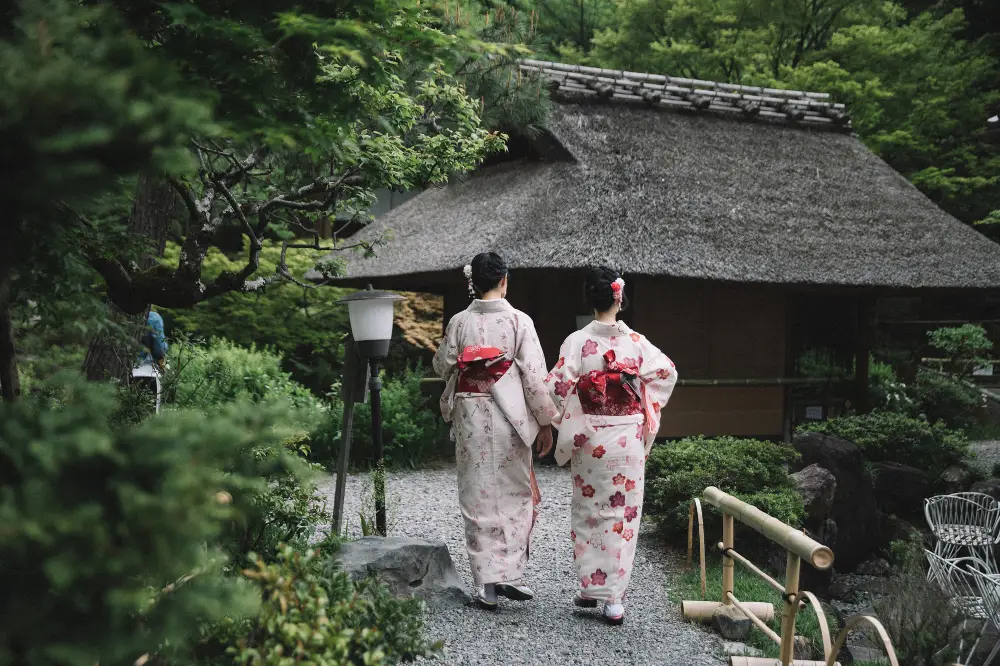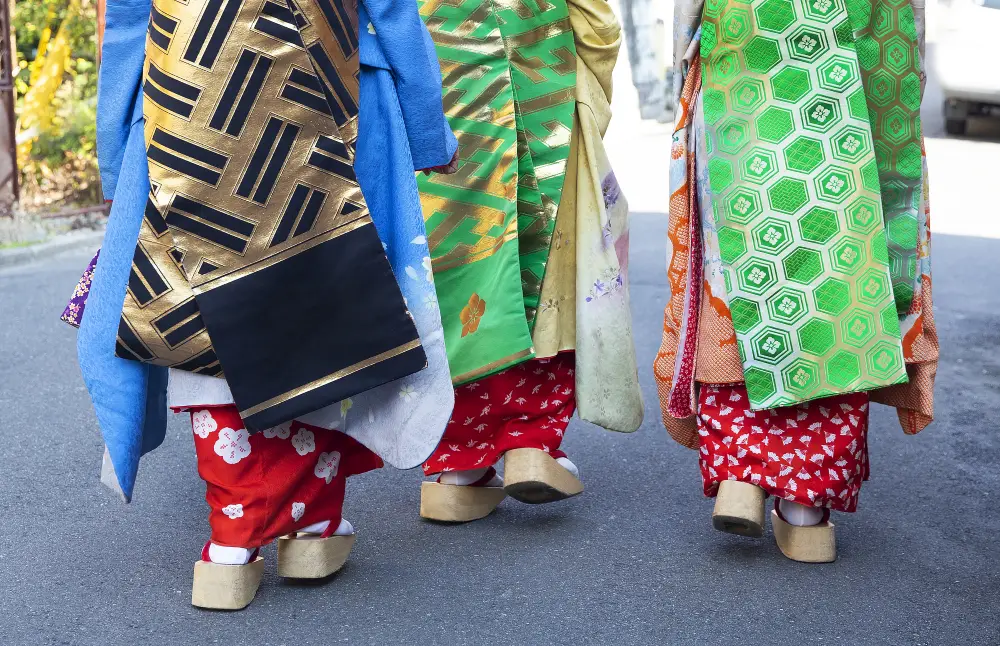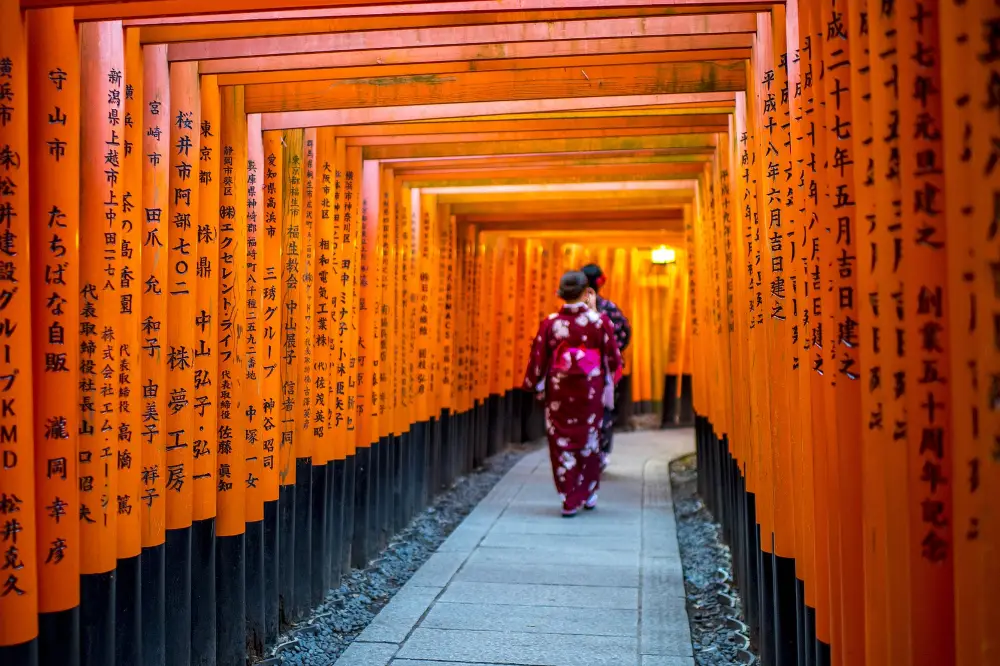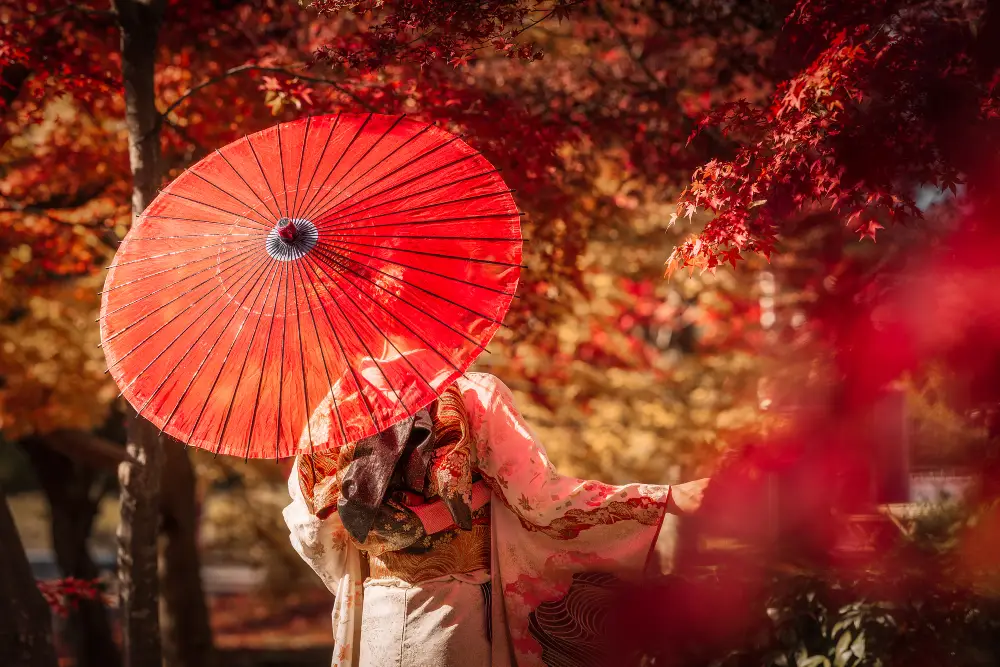2025Kimono Experiences in Kyoto|trip.com

Introduction Kimono Experiences in Kyoto
IntroductionStepping into the thousand-year-old Kyoto, wearing an exquisite kimono, is like embarking on a dream journey through time.

Historical Sedimentation, Cradle of Kimono: Kyoto, as the thousand-year-old capital of Japan, is the birthplace of Kimono culture. In ancient times, the royal family and nobles lived here, and they were very particular about clothing, which promoted the pinnacle of kimono craftsmanship. The kimonos here retain traditional techniques, and the fabrics range from soft silk to crisp brocade, with superior texture; the patterns are exquisitely designed, whether it is elegant flowers and birds or mysterious emblems, they all carry a long history and exude authentic Yamato style.

The ancient city is picturesque, and the kimono adds color: The scenery of Kyoto and kimono complement each other. Strolling along the quaint Hanami path, lined with wooden townhouses on both sides of the stone road, and shuttling through them in gorgeous kimonos, it seems like you are in the Edo period; In the spring, at the Fushimi Inari Taisha, the colorful falling cherry blossoms set off the colorful kimonos; In autumn, at Kiyomizu Temple, the red maple trees cover the kimono with a beautiful background, and every step leads to a beautiful Japanese painting.
Professional support, ultimate enjoyment: Local kimono makeup artists are proficient in traditional aesthetics and create exquisite makeup in the style of kimono, paired with accessories such as hairpins and fans, showing the ancient charm. The photography team is a master of capturing light and shadow, using the eaves of ancient temples and winding paths in the garden as a frame to freeze the amazing moment of the fusion of kimono and Kyoto, allowing people to indulge in this ultimate experience of tradition and beauty.

Coming to Kyoto to experience the charm of the kimono is like opening a treasure box of Japanese culture, immersing yourself in a beautiful realm where quaintness and poetry intertwine.
Trip Moments Kimono Experiences in Kyoto

Yokai Festival in Kyoto 👺
#festivaljoy The Yokai Festival in Kyoto is a unique and thrilling celebration of Japan’s rich folklore, where mythical creatures and spirits, known as "yokai," come to life. It's a perfect opportunity to immerse yourself in the mystical side of Japanese culture while enjoying Kyoto's beautiful fall season. Witness it at Toei Kyoto Studio Park (also known as Eigamura) this autumn along with other Yokai themed activities. 📍Toei Kyoto Studio Park 📆9/14~12/8/24 ⏰9:00-17:00 (weekday) 9:00-19:00 (Weekends and holidays) 🎟️2400¥ (adult) ‼️Don’t miss a special "Uzumasa Great Night Parade of One Hundred Demons" featuring 100 figures on October 26 and December 8 🎁Also, during your visit to the park, don't miss the opportunity to collect stamps and get a Yokai sticker as a reward. #100waysoftravel #kyoto #Yokaifestival

Winter Break in Japan: 4-Day Itinerary
Winter break in Japan, 4-day itinerary! Experience authentic Japanese culture, don't miss it! 🌟🎉 / Japan is located in East Asia and has a long and rich history. 🗾🏯 From Mount Fuji 🗻 to the ancient streets of Kyoto 🏞️, the country exudes a unique island charm. Often referred to as the Land of Cherry Blossoms 🌸, Japan is a great place to explore. / 🎈Itinerary: DAY 1: 🛫 Arrive in Osaka - 🚗 Airport transfer - 🛏 Check in to a hotel in Kyoto Arrive in Japan with ease, enjoy a thoughtful airport transfer, check in to a comfortable hotel, and get ready for an exciting trip! DAY 2: Arashiyama - Sagano Scenic Railway - Kiyomizu-dera Temple - Sannenzaka and Ninenzaka - Yasaka Shrine - Hanamikoji Street Travel through the greenery of Arashiyama, take a scenic train ride, and experience the fusion of nature and history. Visit the tranquility of Kiyomizu-dera Temple, savor the charm of the ancient streets, feel the mystery of the shrine, and enjoy the romance of the ancient capital at night. DAY 3: Kyū Chikurin-in Garden - Enryaku-ji Temple - Hiyoshi Taisha Shrine - Fushimi Inari Taisha Shrine Experience the exquisite Japanese garden at Kyū Chikurin-in, the Zen atmosphere at Enryaku-ji Temple, and pray for your journey at Hiyoshi Taisha Shrine. Finally, stroll through the thousands of torii gates at Fushimi Inari Taisha Shrine, each step is a spiritual cleansing. DAY 4: 🚗 Private transfer - ✈ Kansai International Airport End your wonderful trip to Kyoto with a private transfer to Kansai International Airport, and return home with fond memories. / Must-see attractions: 🚂 Sagano Scenic Railway: Travel along the Hozu River, accompanied by cherry blossoms, and enjoy the spring scenery. ⛩️ Kiyomizu-dera Temple: A tranquil ancient temple surrounded by greenery. Enjoy cherry blossoms in spring and maple leaves in autumn, both seasons are charming. 🌸 Arashiyama: Cherry blossoms and maple leaves dance together, the poetic Togetsukyo Bridge by the Katsura River, and the Zen temples and shrines are thought-provoking. / Travel essentials: 🧳 Don't forget to bring these things when you go to Japan! 📞 SIM card, convenient for contact, no fear of getting lost. 🔌 Plug adapter, Japan has a different voltage, this is a must-have. 🪪 Passport, visa, driver's license, complete documents, worry-free travel. 👚 If you go to Japan in January, bring a thick coat and thermal underwear, don't get cold. 🔋 Charger, power bank, a charged phone is reassuring. 💊 Common medicine and some first aid supplies, just in case. / 🎉 I hope this guide will help you have a more exciting trip to Japan and enjoy your time in the Land of Cherry Blossoms! 🎉

Kimono Experience at Kyoto, Japan 🇯🇵
Visited Japan during December, arrived at Kyoto and headed for Kiyomizu-dera!!! Previously experienced Yukata and the usual Kimonos. Very excited to try on the Furisode-Kimono (Kimono with longer sleeves) this time!!! There are many kimono renting stores in the area, but through thorough research and comparing prices before the trip, we decided to make a reservation online at Okamoto Kiyomizu-dera Shop. We went around the area in our Kimono, took a lot of photos and tried out some authentic Matcha 🍵 and Hojicha desserts.

Fushimi Inari / Kyoto, Japan
1. Address - Fushimi Inari Highlights - Red torii gates / Fox statues Rating - 7/10 ⛩️ If you have plans to fly to Osaka, take a side trip to the neighboring city of Kyoto to see the legendary red torii gates and the fox statues that are symbolic according to Japanese folklore. Actually, the path lined with gates is very long. If you want to walk to the end, it takes almost an hour and a half. For those who like to check in and take photos, you can just walk around the beginning area. It's quite a vibe, haha. When you go up, you'll find a shrine and spots selling charming amulets and wooden plaques for writing wishes, featuring foxes. Around the area, there are food stalls and restaurants lined up for you to try and fill up on. The temple location is a bit far from Kyoto city center. If you're going to Nara, stopping by Fushimi Inari and then heading to Kyoto city is a recommended route.

Kyoto (Fushimi Inari)
Kyoto never stops fascinating visitors with the extraordinary townscape with beautiful shrines and temples. It used to be an ancient capital of Japan until Tokyo took over its place and became the largest center of economy and politics. Walking around the scenic town will take you to world-famous historic sites such as Arashiyama, a peaceful area known for the stunning bamboo grove. Kiyomizudera is a sacred Buddhist temple designated as UNESCO World Heritage Site in 1994. Another highlight you should not miss is Fushimi Inari a Shinto shrine situated at the base of Mt. Inari. The scenic shrine is visited by numerous tourists from around the world as the most popular tourist attraction in Kyoto. It welcomes visitors with Senbon-torii (千本鳥居), which literally refers to a thousand of red Torii gates creating a stunning scenery. Visiting there in the early morning will enable you to take stunning pictures of beautiful Tori gates without crowds. It is also a perfect hiking spot which allows you to explore the mysterious and sacred shrine grounds while feeling the refreshing air. #themeparks

Arashiyama’s Fall 🍂🍁
One of the best trips will be roaming Arashiyama area in Kyoto during the Autumn season. We rented a couple’s Kimono at a nearby shop and there are a few photo spots such as Togetsukyo bridge and Hozu river that are super pretty. The Hozu river with the backdrop of autumn foliage and forested mountainside makes it an attractive photo spot. There are also a few temples/shrines around the area. We went to Hogo-in temple, a quaint temple to enjoy a cup of green tea. Our last stop is the famous Arashiyama bamboo forest. It get pretty crowded in the late morning. Will suggest to come earlier. We actually went to a smaller pathway to get a good photo. The main bamboo forest is too crowded. In 2024, I wish to visit USA for their National Parks 🌳 #2024wish #Kyoto

🇯🇵Stunning Place for Sakura in Kyoto🌸
The location we're in is truly magical, with the breathtaking display of Sakura trees in full bloom. It's an unforgettable experience to witness the delicate petals dancing in the breeze and the vibrant colors of the flowers. What makes this moment even more special is that the Sakura bloomed earlier than predicted, making it feel like a hidden gem that only a fortunate few get to witness. I feel incredibly lucky to be here, savoring the beauty of nature and creating cherished memories that will last a lifetime. #sakura #japan #kyoto #境外遊 #mytripvlog #awesomepic

Tōfuku-ji Temple Kyoto
Tōfuku-ji Temple is located in Kyoto, Japan. It is one of the important temples in the Zen Buddhism sect of Japan. Founded in 1255 by Eisai, the monk who established the Rinzai sect, it is one of the most famous temples in Kyoto. It is especially beautiful during the autumn season when the leaves change color.

To-ji: Kyoto's Heritage Gem
#fallishere Location: 1 Kujocho, Minami Ward, Kyoto, 601-8473, Japan To-ji(東寺) located in Kyoto, Japan, is a historic Buddhist temple with roots dating back to the 8th century. Established in 796, during the Heian period, by Emperor Kanmu, To-ji originally served as a guardian temple for the capital. The main pagoda, standing at 54.8 meters, is the tallest wooden tower in Japan and a designated national treasure. Originally part of a more extensive complex, To-ji played a crucial role in the propagation of Shingon Buddhism, introduced by Kobo Daishi (Kukai). Over the centuries, the temple complex has undergone several reconstructions due to fires and other natural disasters. Today, To-ji remains a UNESCO World Heritage Site, attracting visitors with its rich cultural and religious significance, exquisite architectural structures, and the vibrant atmosphere of its surroundings. #trip #2023travel #2023trip #2023travelwish #2023旅行願望 #timetotravel #tripblazers #historical #heritage #kyoto #japan

Visiting Kinkaku-ji
Kinkaku-ji, located in Kyoto City, Kyoto Prefecture, is a temple of the Rinzai sect of Zen Buddhism. In 1994, Kinkaku-ji, along with Kiyomizu-dera and Ginkaku-ji, was designated as a UNESCO World Cultural Heritage site as part of the Historic Monuments of Ancient Kyoto. Visiting Kinkaku-ji allows you to appreciate its impressive architecture, the picturesque lakeside scenery, and the various exquisite and energy spots scattered throughout the temple grounds. It is one of the most famous temples in Kyoto. The official name of Kinkaku-ji is 'Rokuon-ji,' and Kinkaku-ji is just a common nickname. It is called 'Kinkaku-ji' because of the famous golden pavilion 'Kinkaku' within the temple.

Rurikoin Temple: A dreamlike, light-filled wonderland.
🍒Rurikoin Temple is a dazzling gem set in the earth, exuding endless charm. This ancient temple is steeped in history and culture, attracting every traveler who sets foot here. 💕 Stepping into Rurikoin Temple is like entering a mysterious wonderland. The golden temple glistens in the sunlight like a golden palace. The golden glazed tiles shimmer with colorful light, like stars falling from the sky. The ancient trees in the courtyard stand tall, their lush green leaves swaying gently in the breeze, as if telling ancient stories. Inside the temple, you'll find intricately carved, exquisite Buddha statues. They seem to come to life, exuding majesty and solemnity. Rurikoin Temple is not only a place of faith but also a sanctuary for spiritual cleansing. Every corner and breeze here is filled with kindness and care. Walking on the temple's bluestone path, you can hear the sounds of time and history. Every story is hidden within the temple, and every visit feels like a journey through time. In Rurikoin Temple, people can feel the peace and tranquility flowing from deep within their hearts. It's a silent power that makes people forget worldly troubles and worries. Let's talk about the Buddhist music here. Rurikoin Temple's Buddhist music is like a heavenly melody, enchanting people and making them forget time and space. When the music plays, people can feel the wisdom and compassion of the great monks. This music is like a clear spring, nourishing people's hearts and providing endless comfort and strength. In addition to the beautiful architecture and enchanting music, Rurikoin Temple's cuisine is not to be missed. The vegetarian dishes here are made from natural ingredients, carefully prepared by chefs, and are a feast for the senses. While enjoying the food, people can also feel the chefs' reverence and love for the ingredients. Visitors to Rurikoin Temple are always captivated by everything here. Whether it's the ancient architecture, melodious music, delicious food, or rich cultural atmosphere, people are reluctant to leave. Every visit brings a sense of inner peace and tranquility. This is not just a tourist attraction but a place to release the shackles of the heart. Moreover, Rurikoin Temple is a great place to learn about Buddhist culture. Here, people can gain a deeper understanding of Buddhist history, culture, and teachings, and learn about Buddhism's positive impact on people's lives. It's a rare opportunity and a chance to explore one's inner world. In short, Rurikoin Temple is a beautiful and mysterious place. Its unique charm attracts everyone who comes here. Whether it's the architecture, music, food, or cultural atmosphere, people are reluctant to leave. If you haven't been here yet, take action now! You'll surely be captivated and enchanted by everything here!

Yakatabune Boat Ride & Oden on a Boat: A Serene Autumn Escape on the Katsura River in Arashimaya
#newyearnewtrip The Yakatabune rental boat ride in Arashimaya stands out as one of the most enchanting and serene experiences in Japan, especially during the captivating autumn season. Departing from the Arashimaya Tsusen North Boarding Area, this 30-minute private charter offers an intimate journey along the south side of the Katsura River, providing a unique way to experience the natural beauty of the area. The traditional Yakatabune boat, with its elegant wooden design, gently glides across the river as the boatman skillfully rows, allowing passengers to soak in the breathtaking autumn views. The riverbanks are adorned with a stunning array of autumn foliage, where fiery reds, rich oranges, and golden yellows create a vivid tapestry of color. The calm water mirrors this vibrant display, enhancing the sense of tranquility and offering the perfect setting for relaxation and reflection. A truly special aspect of this boat ride is the opportunity to stop at another boat that serves oden, a traditional Japanese dish made of simmered vegetables, tofu, and fish cakes in a warm broth. Savoring a steaming bowl of oden while floating on the river, with the stunning autumn leaves surrounding you, creates a remarkable fusion of comfort, culture, and nature. The warmth of the dish, paired with the cool autumn air, heightens the sensory experience, making it feel like a moment out of a dream. The entire journey along the Katsura River feels like an immersive experience that connects passengers to the tranquil beauty of Arashimaya in a way that few other activities can match. Whether you’re gliding past the lush riverbanks or savoring a comforting bowl of oden, the Yakatabune boat ride offers a truly unforgettable and peaceful way to take in the stunning autumn scenery of Kyoto. This tranquil and scenic ride is not just a leisurely activity but a serene escape into the heart of nature, making it an essential experience for anyone visiting Arashimaya.


